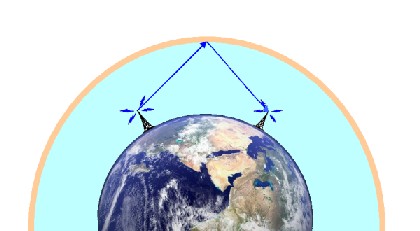|
|
|
|
Radiocommunication is the transmission
of signals between two places by means of the transmission and reception of
electromagnetic waves. These waves spread quickly (approx.
300,000 km/sec in vacuum) and do not need any carrier, in contrast to
traditional telegraphy which requires wires. Furthermore, producing and
receiving radio waves is simple and does not require a large amount of energy.
The induction of an electric current in
a wire produces an electromagnetic field around the wire, and this field has a
certain amount of energy. By quickly changing the current in the wire, the
energy of the field also changes and an electromagnetic wave spreads into the
space; this can be picked up by a receiver made from another wire through which
runs an electric current. When it is hit by the wave produced by the first
wire, the electromagnetic field of the receiver changes, reflecting the
characteristics of the transmitted wave, i.e. the transmitted signal.
We
make a radiocommunication system by replacing these electric wires with aerials
positioned high in the air and linked to instruments which can produce and
measure the variations in the electromagnetic field.
In the mid 19th century F.
Clerk Maxwell came up with a theory on the propagation of electromagnetic waves. This was confirmed with experiments in 1886-87 by H. R. Herz, although he
excluded the idea of any practical applications. Experimental confirmation of
Maxwell’s electromagnetic theory of light were
taken up and extended shortly afterwards by A. Righi.
Towards the end of the 19th
century, various scientists were busy using different methods to investigate the
possibility of transmitting signals over a distance without wires by making use
of the electromagnetic waves in the atmosphere. These included Branly, Hughes,
Lodge, Popov, Crookes, Preece and N. Tesla. But Marconi was the first to put
his ideas into practice and to find technically viable applications in the form
of transmissions, and his personal and commercial success was enormous.
In
those days it was thought that electromagnetic waves spread in the same way as
light waves and that, consequently, they were restricted by natural obstacles,
as light waves are. Marconi proved otherwise.
 Fig. 2: Radio waves are repeatedly refracted and therefore finally "reflected" by the layer of the ionosphere. This allows for transmission between two points which are far from each other on the globe, despite the curvature of the earth. |
His transatlantic transmission experiment in 1901 showed that the curvature of the Earth did not impede the transmission of signals, as many scientists had believed. In 1902 A. E. Kennelly and O. Heaviside, working independently from each other, tried to find an explanation for the successful transatlantic experiment. They came up with the idea that in the upper atmosphere there was an ionized gas which acts like a "mirror", reflecting back towards earth the electromagnetic radiations emitted from the transmission post.